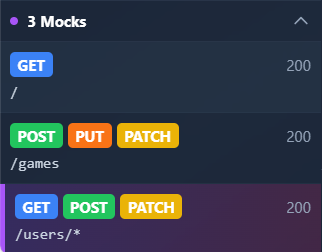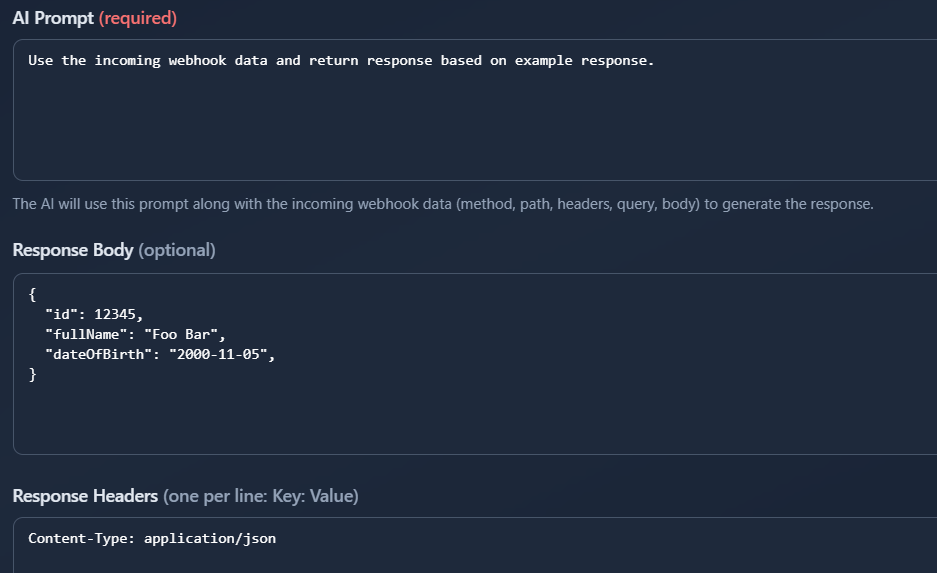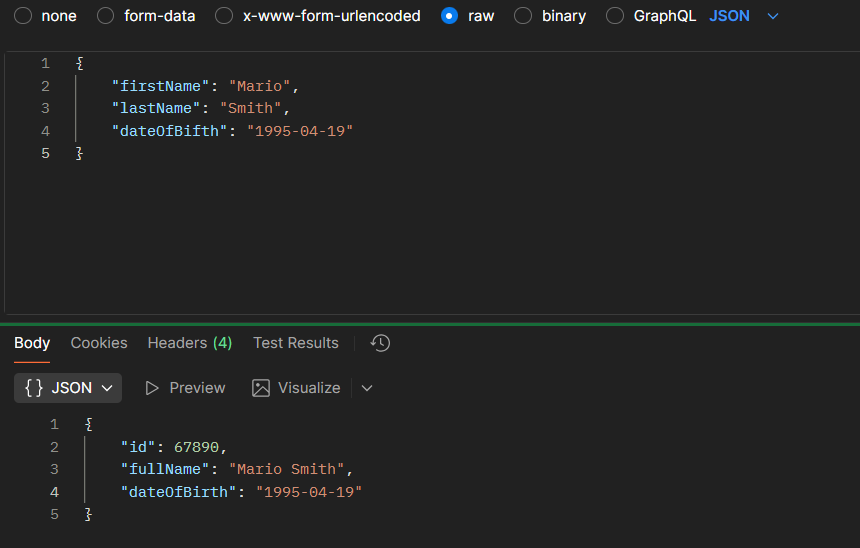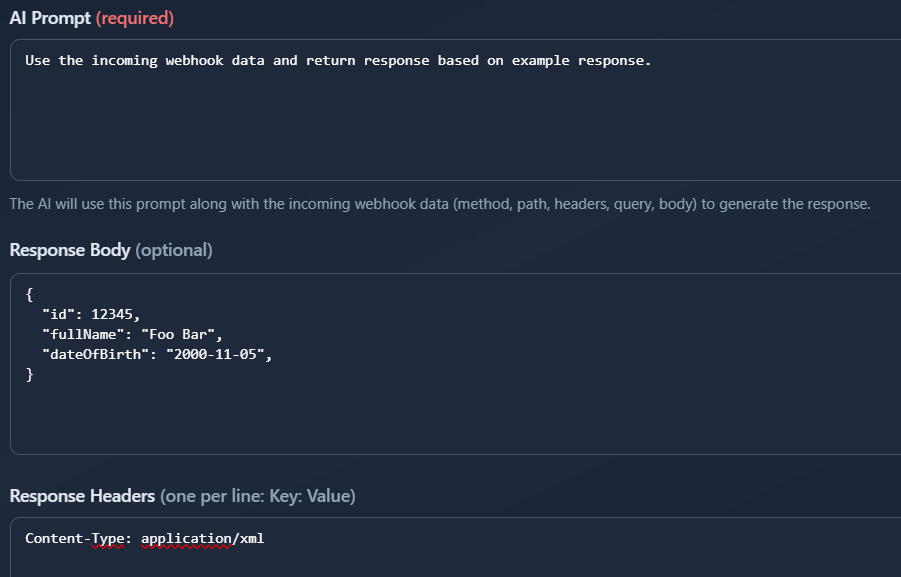Mock Responses
Learn how to create intelligent mock responses that automatically respond to webhook requests with customizable status codes, bodies, and AI-generated content.
Mock panel

The sidebar provides a clear and organized list of all the configured mocks, allowing you to navigate through them effortlessly.
You can click on any mock in the sidebar to instantly load its configuration.
You can also collapse the panel if needed.
Overview
Mock responses allow you to configure automatic responses to incoming webhook requests. This is perfect for:
- Frontend development - Mock backend APIs without running a server
- Testing webhook consumers - Simulate various response scenarios
- Integration testing - Test error handling and edge cases
- API prototyping - Quickly prototype API behavior
Key Features
- Pattern-based matching - Use wildcards to match multiple paths
- Method filtering - Different responses for different HTTP methods
- Custom status codes - Simulate success, errors, and edge cases
- Custom headers - Add any response headers
- AI-powered responses - Generate dynamic responses based on request data
- Multiple mocks per bin - Create complex routing scenarios
Creating Mock Responses
Configuration
Click the mock icon in the bin header:
No Active Mock
Two Active Mocks
Mock Response Creation
Configuration Fields
1. Path Pattern
Define which URLs this mock should match
Supported Patterns:
Exact Match
/api/users
Matches: /api/users only
Wildcard at End
/api/users/*
Matches:
/api/users/123/api/users/456/profile/api/users/any/nested/path
Wildcard in Middle
/api/*/users
Matches:
/api/v1/users/api/v2/users/api/public/users
Multiple Wildcards
/api/*/users/*
Matches:
/api/v1/users/123/api/v2/users/456/profile
Root Wildcard
/*
Matches: Any path
Examples
// Match all webhook paths
path: "/webhooks/*"
// Match versioned API
path: "/api/v*/users"
// Match any path
path: "/*"
// Match specific endpoint
path: "/api/payments/callback"
2. HTTP Methods
Select which HTTP methods trigger this mock:
Available Methods:
- GET
- POST
- PUT
- PATCH
- DELETE
- OPTIONS
- HEAD
Multiple Selection:
- Select multiple methods for the same mock
- Create method-specific responses by duplicating mocks with different methods
Examples:
// RESTful resource
methods: ["GET", "POST", "PUT", "DELETE"]
// Read-only endpoint
methods: ["GET", "HEAD"]
// Write operations only
methods: ["POST", "PUT", "PATCH"]
// Webhook endpoint
methods: ["POST"]
3. Status Code
HTTP status code for the response:
Common Status Codes:
| Code | Meaning | Use Case |
|---|---|---|
| 200 | OK | Successful GET, PUT, PATCH |
| 201 | Created | Successful POST creating resource |
| 202 | Accepted | Async processing accepted |
| 204 | No Content | Successful DELETE |
| 400 | Bad Request | Invalid input testing |
| 401 | Unauthorized | Auth testing |
| 403 | Forbidden | Permission testing |
| 404 | Not Found | Missing resource testing |
| 422 | Unprocessable Entity | Validation error testing |
| 500 | Internal Server Error | Server error testing |
| 503 | Service Unavailable | Downtime testing |
Examples:
// Success scenarios
statusCode: 200 // OK
statusCode: 201 // Created
statusCode: 204 // No Content
// Client error scenarios
statusCode: 400 // Bad Request
statusCode: 404 // Not Found
statusCode: 422 // Validation Error
// Server error scenarios
statusCode: 500 // Internal Server Error
statusCode: 503 // Service Unavailable
4. Response Body
Optional response body content:
Supported Formats:
JSON
{
"success": true,
"message": "User created successfully",
"user": {
"id": 123,
"email": "user@example.com",
"createdAt": "2025-01-15T10:30:00Z"
}
}
XML
<?xml version="1.0" encoding="UTF-8"?>
<response>
<success>true</success>
<message>User created successfully</message>
<user>
<id>123</id>
<email>user@example.com</email>
</user>
</response>
Plain Text
Success: User created
ID: 123
Empty Body
Leave blank for no response body (useful for 204 No Content)
5. Response Headers
Optional custom response headers:
Format: One header per line, Key: Value
Examples:
Content-Type: application/json
X-Custom-Header: custom-value
Cache-Control: no-cache
X-Request-ID: abc-123
Common Headers:
Content-Type: application/json
Content-Type: application/xml
Content-Type: text/plain
Content-Type: text/html
Content-Type: application/pdf
Cache-Control: no-cache
Cache-Control: max-age=3600
Access-Control-Allow-Origin: *
Access-Control-Allow-Methods: GET, POST, PUT, DELETE
Access-Control-Allow-Headers: Content-Type, Authorization
X-RateLimit-Limit: 100
X-RateLimit-Remaining: 95
X-RateLimit-Reset: 1642243200
6. AI-Powered Responses
Enable AI to generate dynamic responses based on incoming request data:
AI Prompt:
When AI is enabled, provide a prompt that describes how to generate the response:
Example Prompts:
"Analyze the incoming webhook data and respond with a JSON object containing:
- A confirmation message
- The received HTTP method
- The current timestamp
- An echo of any user data sent
Make the response friendly and professional."
"Generate a realistic API response for a user creation webhook. Include:
- A generated user ID (random number)
- The email from the request body
- A success message
- A timestamp
Format as JSON."
"Use the incoming webhook data and return response based on example response."
| Mock Example | Response |
|---|---|
 |  |
Changing the Content-Type header:
| Mock Example | Response |
|---|---|
 |  |
AI Context:
The AI receives:
- Request method
- Request path
- Request headers
- Request query parameters
- Request body
- Response body example
- Response body headers
- Your prompt
Benefits:
- Dynamic responses based on input
- Realistic test data
- Context-aware responses
- Complex business logic simulation
Related Topics
- Bins: Learn about webhook endpoints
- Forward Requests: Forward webhooks to your server
- Snapshot: Create snapshot to share with devs